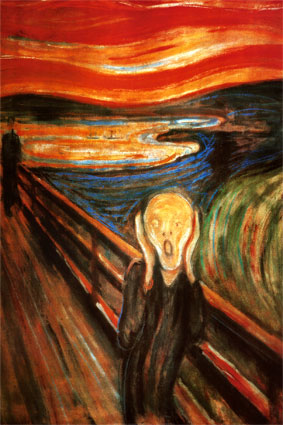The expressionist movement is one of the more modern movements, starting in the late 19th century through early 20th century. Expressionism is an art form in which the artist attempts to portray not objective reality but rather the subjective emotions and responses that objects and events arouse in him. The artist accomplishes this through distortion, exaggeration, primitiveness, and fantasy and through the vivid, jarring, violent, or dynamic application of formal elements.
Unlike Impressionism, its goals were not to reproduce the impression suggested by the surrounding world, but to strongly impose the artist’s own sensibility to the world’s representation. The expressionist artist substitutes to the visual object reality his own image of this object, which he feels as an accurate representation of its real meaning. The search of harmony and forms is not as important as trying to achieve the highest expression intensity, both from the aesthetic point of view and according to idea and human critics.
Expressionism started mostly in Germany, in 1910. As an international movement, expressionism has also been thought of as inheriting from certain medieval artforms and, more directly, Cézanne, Gauguin, Van Gogh and the fauvism movement.
The most well known German expressionists are Max Beckmann, Otto Dix, Lionel Feininger, George Grosz, Ernst Ludwig Kirchner, August Macke, Emil Nolde, Max Pechstein; the Austrian Oskar Kokoschka, the Czech Alfred Kubin and the Norvegian Edvard Munch are also related to this movement. During his stay in Germany, the Russian Kandinsky was also an expressionism addict.

Scream by Edvard Munch
Credit: Pioch, Nicolas. “Expressionism.” BMW Foundtion, 2002. Web. <http://www.ibiblio.org/wm/paint/tl/20th/expressionism.html>.
